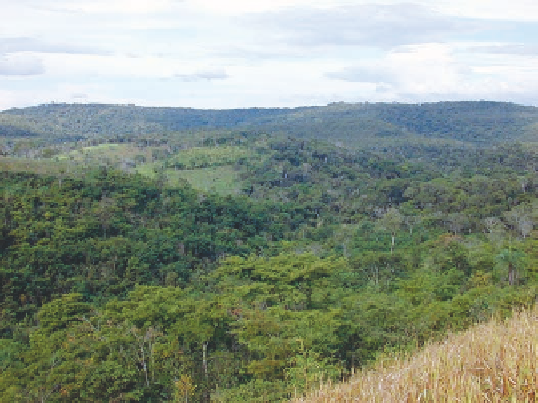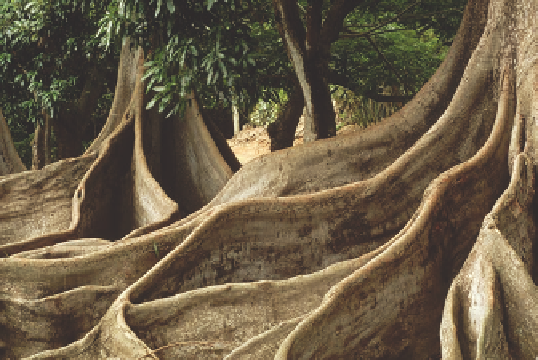Geoscience Reference
In-Depth Information
Figure 10.8 Buttress roots at the base of an emergent tree
in the rainforest.
These roots give support to the tall trees that
extend to heights of 40 m to 60 m (130 ft to 200 ft).
Figure 10.9 Example of the tropical deciduous forest.
Although this is a low-latitude region, note that the trees are
relatively short and the canopy is more open than in the tropical
rainforest biome.
Beneath the rainforest canopy is a third layer, called the
understory,
consisting of another dense network of interwoven
branches and leaves that is 5 m to 15 m (15 ft to 50 ft) high
(Figure 10.7). In conjunction with the upper canopy, this dense
layer blocks sunlight from reaching the forest floor where the
ground layer occurs. Given the shady character of the lower
forest, the vegetation in this fourth layer of the rainforest is un-
evenly distributed and ranges from 0 m to 5 m (0 ft to 15 ft)
above ground level. Contrary to the general assumption most
have about the character of the ground-level rainforest, many
places are open—that is, you could walk through them more
easily than you might think. Only where distinct openings in the
rainforest canopy are present, such as along streams, does suf-
ficient light reach the forest floor so that dense
jungle
vegetation
can grow.
(hence, the name tropical
deciduous
forest). This environment
also has less overall species diversity and total biomass than the
rainforest. Nevertheless, this biome has a greater array of shrub-
like species and smaller plants at ground level because more
sunlight reaches the forest floor (Figure 10.9). This enhanced
ground-level sunlight is due to the upper canopy of the forest
being less dense than in the tropical rainforest.
The vegetation gradually shifts from tropical deciduous
forest to tropical scrub in areas where average annual rainfall
is closer to 130 cm (50 in.). Tropical scrub consists mostly of
low-growing, deciduous trees that reach heights ranging from
3 m to 9 m (10 ft to 30 ft; Figure 10.10). These trees tend to be
ragged-looking due to the relative lack of moisture, and they
vary in density from being closely bunched to widely spaced.
With increased distance between the trees, a lower level of tall
Tropical Deciduous Forest and Scrub Biome
The sec-
ond major subdivision within the tropical forest biome is the
tropical deciduous forest and scrub plant community. Exten-
sive areas of tropical deciduous forest and scrub vegetation oc-
cur in Africa, South America, India, and Southeast Asia (see
Figure 10.6). This plant subdivision is associated with the rela-
tively dry tropical environments where annual precipitation is
from 130 cm to 200 cm (50 in. to 80 in.), which occur due to a
distinct seasonal dry cycle. These areas are found within both
the tropical monsoon climates (
Am
) and the more humid parts
of the tropical savanna climates (
Aw
). Although the temperature
varies more in these areas than in the tropical rainforest regions,
it is always warmer than 18°C (64°F).
The tropical deciduous forest and scrub plant assemblage
reflects the progressive transition to a drier climate at higher
tropical latitudes. In the wetter areas, where average annual
precipitation is closer to 200 cm (80 in.), the vegetation is
dominated by tropical deciduous forest (see Figure 10.6 again).
Although these areas contain many of the same species seen in
the tropical rainforest, they are not as tall and are not evergreen.
In other words, they drop their leaves during the dry season
Figure 10.10 Tropical scrub vegetation in the Australian Out-
back.
Note the ragged-looking trees and the scrubby understory.





